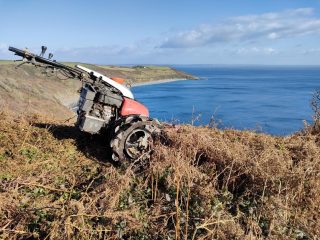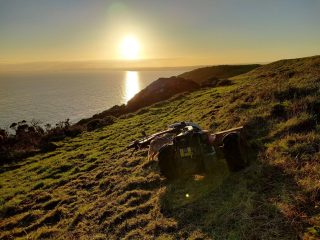The past couple of months have been very busy for the ranger team. We have completed our ash dieback work. All our ash trees were surveyed in the summer and any showing 50% or more crown loss were marked up to be taken down especially along footpaths and around busy car parks. It is very sad to see so many trees getting the disease but there is hope some will be resistant so where it is safe to do so we will leave the ash trees alone.
Thankfully we have been planting trees too! Two orchards, 120 fruiting trees, and 1000 sessile oak trees at Messack. Thank you to all the volunteers who came out and helped us.
 We have also managed to fit in our annual winter cuts along the coast. You may have seen us out on Nare Head or the Dodman flailing and brushcutting the coastal slopes. This is primarily to keep back the bramble and gorse from taking over and allowing the maritime grassland to flourish.
We have also managed to fit in our annual winter cuts along the coast. You may have seen us out on Nare Head or the Dodman flailing and brushcutting the coastal slopes. This is primarily to keep back the bramble and gorse from taking over and allowing the maritime grassland to flourish.
On Nare Head we are also maintaining suitable habitat for the rare lichens found on the rocks here. We need to keep the rocks free from encroaching gorse as this effects the microclimate the lichen needs to survive. In 1989 a survey found Nare Head to be nationally important for its lichen with around 180 species recorded. Highlights were Rocella phycopsis and Lecanora praepostera, both of which are currently listed as Nationally Scarce. In 2000 another survey found a different story, only 76 species were found, two of which (Buella subdisciformis and Trapeliopsis wallrothii) were Nationally Scarce at the time. The reduction was down to encroachment of gorse scrub around the rocky outcrops. Most recently in 2010 another survey found 105 species, 7 of which were on the red data lists and nationally scarce. Our yearly management is key to preserving the rich and rare diversity of lichens.
rocky outcrops. Most recently in 2010 another survey found 105 species, 7 of which were on the red data lists and nationally scarce. Our yearly management is key to preserving the rich and rare diversity of lichens.
On the Dodman the clearance also maintains access to archaeologically important structures such as the bulwark that would have been part of an iron age cliff castle. This is the large ditch and rampart structure that cuts off the headland East to West. On the Eastern side, within the bulwark, you will see an area of mounds and ditches and quarries, this is thought to be the remains of a settlement. We also maintain the area around the watch house, which is thought to be late eighteenth century or early nineteenth century, and the nineteenth century granite cross at the end of the headland. There are two bronze age barrows which fall within the tenant’s management.
At Treluggan we are improving suitable habitat for the rare hairy birdsfoot trefoil found here, clearing scrub to extend areas within which it can spread.
Management of the sites is also helped by our grazing ponies throughout the year.
If you’d like more information or to volunteer email roseland@nationaltrust.org.uk

